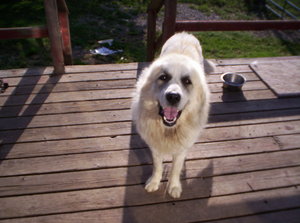The Great Pyrenees is a beautiful and majestic dog. Known as the “Gentle Giant,” these large breed dogs are favored by both farmers looking for a dog to defend their livestock, as well as families looking for a guardian dog that is gentle with children.
Grooming a Great Pyrenees however, can be a difficult endeavor. The Great Pyrenees is a great cold weather dog, with it’s thick long fur, but can also live well in warmer conditions as well. Given the fact that these dogs do have such thick and long fur however, they do require consistent grooming to keep them in good health.
Grooming for a Great Pyrenees should cover it’s entire body. From inside their ears down to their toenails, the Great Pyrenees requires grooming that encompasses their entire body. Fortunately, even though they are such a large dog, proper grooming requires no more than 30 minutes or so a week, with longer grooming processes about once a month or so.
Tips for Grooming a Great Pyrenees’ Coat
At first glance, many people think that maintaining the coat of a Great Pyrenees would be a difficult job. In reality, this couldn’t be further from the truth. The Pyrenees has a coat which is naturally tangle resistant, and is considered to be “self-cleaning” in the sense that their fur has a unique, natural ability to shed dirt on it’s own.
Even so, your Pyrenees’ coat will require some help from you, in order to keep it looking it’s best. Weekly brushing with a wire card brush will help to remove loose hair and debris from the dog, and help keep their coat smooth. During shedding season, you may want to brush with a special brush designed to move the undercoat, however it is important to keep in mind that you do not want to brush too often, because this can cause hair breakage for the dog.
As with any dog, you don’t want to bathe your Pyrenees too much, because this removes beneficial and natural oils from the dogs coat. When you do bathe your Pyrenees, use a gentle shampoo, such as baby shampoo, to help prevent the removal of these oils. You should bathe your dog no more than once a month, and make sure to properly dry and brush him after their bath.
It is interesting to note, that Pyrenees often do end up with mats of fur behind their ears. This usually comes from people petting them on their heads and behind their ears. The oils from our skin get transferred onto the dogs fur, and causes it to mat. To prevent this from occurring, simply sprinkle a little bit of power behind the dogs ears now and then to help absorb this oil, and keep the mats from occurring.
Tips for Grooming a Great Pyrenees’ Ears
Given the fact that Great Pyrenees’ ears droop, rather than stand up, and that they have a lot of hair around their ears, you will need to devote some of your grooming time to properly caring for their ears. If you’ve never cleaned a dogs ears before, you might be a little bit apprehensive about it, but don’t worry. It’s really not that difficult.
Raise the dogs ear so that you can clearly see inside. If there is any wax or dirt build up, you will need to remove it so that the dog does not develop any type of ear infection or mites. There are various ear powders and liquids on the market that you can use to clean the ear, which will help to remove the wax and dirt with very little work from you.
If you have experience cleaning your dogs ears, and your dog is well behaved and will sit still, you can also try to remove the wax and dirt with a Q-tip. This is a very delicate procedure though, because if the dog moves suddenly and the Q-tip is inserted too far into the ear, it can cause severe damage. So if you have never done this before, and your dog moves around a lot, you should avoid this method.
You may be tempted to trim the hair that is around your dogs ears, thinking that it will give you easier access to the ear canal for cleaning. This is something that you absolutely should not do! Your Pyrenees has hair in front of it’s ears for a reason. The hair is there to block dirt and debris from getting into the ear canal. So leave the hair where it is, and just work around it when cleaning. Routine use of an ear cleaning powder will prevent any build up from occurring, and make ear cleaning and ear care easy.
Tips for Grooming a Pyrenees’ Nails
Great Pyrenees have extremely large feet. This means they also have extremely large nails. You will need to trim your dogs nails, or have them trimmed, to prevent them from getting too long. If your dog is very active, and spends a lot of time running, you can probably get away with trimming the nails every 2-3 months. Make sure and trim the dew claws as well, since these claws often get forgotten.
The Pyrenees is special in the fact that they have double dew claws on their rear legs. This claws need to be trimmed just as regularly as the other claws. What many people are unaware of, is that if the dew claws are not regularly maintained, they can actually curve and grow into the dogs skin, which can cause a multitude of health problems. Make sure and have your Pyrenees’ nails trimmed regularly, so that no complications occur.





